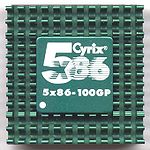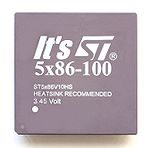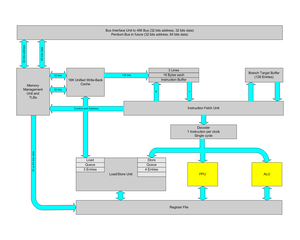
Cyrix Cx5x86
Encyclopedia



Cyrix 6x86
The Cyrix 6x86 is a sixth-generation, 32-bit 80x86-compatible microprocessor designed by Cyrix and manufactured by IBM and SGS-Thomson. It was originally released in 1996.-Architecture:...
, the Cyrix
Cyrix
Cyrix Corporation was a microprocessor developer that was founded in 1988 in Richardson, Texas as a specialist supplier of high-performance math coprocessors for 286 and 386 microprocessors. The company was founded by former Texas Instruments staff members and had a long but troubled relationship...
5x86 was one of the fastest CPU
Central processing unit
The central processing unit is the portion of a computer system that carries out the instructions of a computer program, to perform the basic arithmetical, logical, and input/output operations of the system. The CPU plays a role somewhat analogous to the brain in the computer. The term has been in...
s ever produced for Socket 3
Socket 3
Socket 3 was one of the series of CPU Sockets into which various x86 microprocessors were inserted. It was sometimes found alongside a secondary socket designed for a math coprocessor chip, in this case the 487. Socket 3 resulted from Intel's creation of lower voltage microprocessors...
computer
Computer
A computer is a programmable machine designed to sequentially and automatically carry out a sequence of arithmetic or logical operations. The particular sequence of operations can be changed readily, allowing the computer to solve more than one kind of problem...
systems. With better performance in most applications than an Intel Pentium processor at 75 MHz, the Cyrix Cx5x86 filled a gap by providing a medium-performance processor option for 486
Intel 80486
The Intel 80486 microprocessor was a higher performance follow up on the Intel 80386. Introduced in 1989, it was the first tightly pipelined x86 design as well as the first x86 chip to use more than a million transistors, due to a large on-chip cache and an integrated floating point unit...
Socket 3 motherboard
Motherboard
In personal computers, a motherboard is the central printed circuit board in many modern computers and holds many of the crucial components of the system, providing connectors for other peripherals. The motherboard is sometimes alternatively known as the mainboard, system board, or, on Apple...
s (which are incapable of handling Intel's Pentium CPUs, apart from the Pentium Overdrive
Pentium OverDrive
The Pentium OverDrive was a microprocessor marketing brand name used by Intel, to cover a variety of consumer upgrade products sold in the mid 1990s. It was originally released for 486 motherboards, and later some Pentium sockets...
).
The Cyrix 5x86 processor, codename "M1sc", was based on a scaled-down version of the "M1" core used in the Cyrix 6x86, which provided 80% of the performance for a 50% decrease in transistor
Transistor
A transistor is a semiconductor device used to amplify and switch electronic signals and power. It is composed of a semiconductor material with at least three terminals for connection to an external circuit. A voltage or current applied to one pair of the transistor's terminals changes the current...
s over the 6x86 design. It had the 32-bit
32-bit
The range of integer values that can be stored in 32 bits is 0 through 4,294,967,295. Hence, a processor with 32-bit memory addresses can directly access 4 GB of byte-addressable memory....
memory bus of an ordinary 486 processor, but internally had much more in common with fifth-generation processors such as the Cyrix 6x86, the AMD K5
AMD K5
The K5 was AMD's first x86 processor to be developed entirely in-house. Introduced in March 1996, its primary competition was Intel's Pentium microprocessor. The K5 was an ambitious design, closer to a Pentium Pro than a Pentium regarding technical solutions and internal architecture...
, and the Intel Pentium, and even the sixth-generation Intel Pentium Pro
Pentium Pro
The Pentium Pro is a sixth-generation x86 microprocessor developed and manufactured by Intel introduced in November 1, 1995 . It introduced the P6 microarchitecture and was originally intended to replace the original Pentium in a full range of applications...
. The chip featured near-complete support for i486 instructions, but very limited support for Pentium instructions. Interestingly, some performance-enhancing features of the CPU were intentionally disabled due to potentially stability-threatening bugs which were not fixed before release time (these features can be enabled with freely downloadable software utilities; see below).
The similarly named SGS-Thomson ST5x86 and IBM IBM5x86C
IBM5x86C
The IBM 5x86C is an IBM-branded and -produced version of the Cyrix-designed Cyrix Cx5x86 CPU.Previous IBM x86 processors, IBM 386SLC and IBM 486SLC, were based on modified Intel designs.-Specifications:*iDX4WB pinout, 168 pins*Socket 3...
were licensed rebrandings of the Cyrix design (IBM and ST physically produced Cyrix's CPUs for them), marketed separately but identical for practical purposes, apart from the availability of a 75 MHz edition which Cyrix did not bring to market, and slight differences in voltage requirements. The Cyrix 5x86 design, however, should not be confused with the similarly named AMD Am5x86
AMD 5x86
The Am5x86 processor is an x86-compatible CPU introduced in 1995 by AMD for use in 486-class computer systems. It was one of the fastest, and most universally-compatible upgrade paths for users of 486 systems....
which was essentially a fast 486 (not an all-new design like the Cyrix part) but which had broadly similar performance, used the same Socket 3, and was introduced at the end of the same year.
Cyrix's 5x86 was a very short-lived chip, having a market life of only six months. It is likely Cyrix could have continued to successfully sell processors based on Socket3, but canned the 5x86 so that it would not compete with its then new 6x86 offerings.
Controversies & Anomalies
The official Cyrix 5x86 website boasted about several features of the chip that were disabled by default in the final versions. The most controversial of these features was the "branch-prediction" feature, which was enabled in the benchmarks results on the company website when comparing the chip to Intel's Pentium processor. While it was possible to enable the extra features using a special software utility, it usually resulted in an unstable system, especially on earlier steppings of the chip when running 32-bit code.There are also many rumours surrounding a 133MHz, clock-quadrupled version of the Cyrix 5x86. The 133 MHz version is very rare, however, and producers of upgrade kits were given preferential access to it, notably Gainbery. It has been suggested that all of the 120MHz parts also contain support for the 4X multiplier setting (most 100MHz models do not), and some of these chips may also work at 133MHz. However, the 5x86 is not known to overclock well, and 120MHz is generally considered to the pushing the limitations of the process on which it was fabricated. An 80MHz (2x40MHz) 5x86 also exists, but is unclear as to whether or not it was ever officially released.
IBM's 5x86 is considered to be a more conservatively rated chip. For example, what Cyrix would normally rate as a 100MHz part, IBM would mark as 75MHz. This would also explain the differences in the voltage requirements. The IBM part was normally only available in 75 and 100MHz parts, but examples of 120MHz parts are known to exist.
Specifications

- iDX4WB pinout, 168 pins
- Socket 3Socket 3Socket 3 was one of the series of CPU Sockets into which various x86 microprocessors were inserted. It was sometimes found alongside a secondary socket designed for a math coprocessor chip, in this case the 487. Socket 3 resulted from Intel's creation of lower voltage microprocessors...
- 2.0 million transistors on 0.65 micrometre process
- 144mm² die
- 3.45 volts
- 16 kilobyteKilobyteThe kilobyte is a multiple of the unit byte for digital information. Although the prefix kilo- means 1000, the term kilobyte and symbol KB have historically been used to refer to either 1024 bytes or 1000 bytes, dependent upon context, in the fields of computer science and information...
s unified level-one cache
100 MHz capable edition for 33 MHz (33×3), and 50 MHz (50×2) front side bus
Front side bus
A front-side bus is a computer communication interface often used in computers during the 1990s and 2000s.It typically carries data between the central processing unit and a memory controller hub, known as the northbridge....
100 MHz capable edition for 33 MHz (33×3), and 25 MHz (25×4) front side bus
Front side bus
A front-side bus is a computer communication interface often used in computers during the 1990s and 2000s.It typically carries data between the central processing unit and a memory controller hub, known as the northbridge....
120/133 MHz capable edition for 40 MHz (40×3) and 33 MHz (33×4) front side bus.
External links
- Comparative performance benchmarks
- Cyrix 5x86
- Cyrix 5x86 Processor Brief
- Entry in 486 processors chart
- Performance-enhancing utility to enable 5x86 "register bits"
- Information on write-back cache performance-enhancing utility from Evergreen Tech(see "Cyrix5x86" section in the middle of the page and "et9603.exe" hyperlink)

